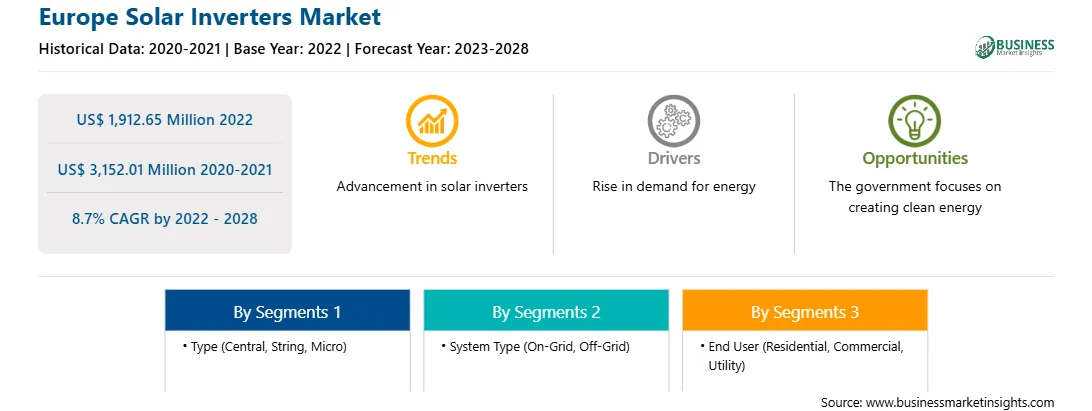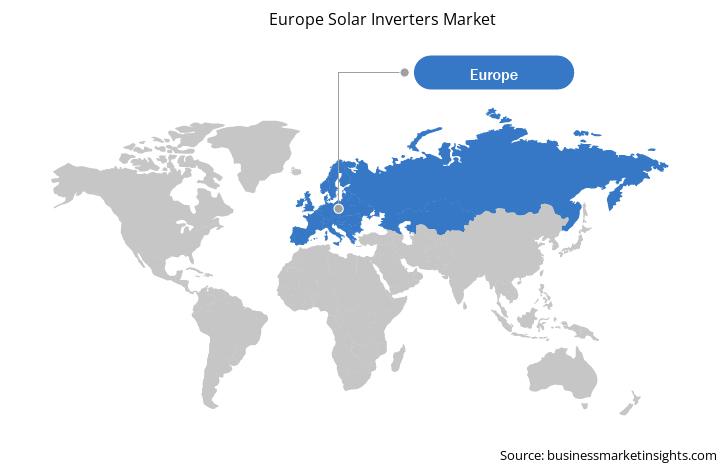The Europe solar inverters market is expected to reach US$ 3,152.01 million by 2028 from US$ 1,912.65 million in 2022; it is estimated to grow at a CAGR of 8.7% from 2022 to 2028.
Due to the high penetration level of distributed energy resources (DER), the grid poses many complex challenges to the functioning of inverters. As a solution for these common problems, smart inverters come into play by solving most of the problems of the traditional system. Since smart inverters work autonomously, they have a positive impact on the implemented residential sector, as well as the national power grid. Due to the stress, the traditional grid requires constant maintenance, but smart inverters could help address these localized challenges and grow the system's flexibility. Smart inverters allow two-way communication with utility control centers. In addition, advanced capabilities such as voltage and frequency sensors allow smart inverters to detect grid abnormalities and send feedback to utility operators. The necessity of a smart solar inverter has been increasing day by day. Smart inverter technology provides some advantages to residential, commercial, and utility-scale solar, which includes high redundancy through a distributed alternating current (AC) architecture that reduces system cost and improves operations and maintenance. Smart inverters function as the brain of photovoltaic (PV) systems, which are responsible for monitoring, communications, smart energy management, grid interaction, storage, and safety. Further, Delta's smart solar inverter solutions enable smart and cost-effective designs for industrial and small utility-scale PV power plants by maximizing energy yields even in challenging landscapes and locations. Smart inverters will have more direct current (DC) overloading options, flexible maximum power point tracking (MPPT) channels, fuse-less or in-line fuse options, and wireless communication systems. Thus, smart inverter technology in the solar inverter category will create future opportunities for the Europe solar inverters market players. The Europe solar inverter market is expected to grow at a good CAGR during the forecast period.

Strategic insights for the Europe Solar Inverters provides data-driven analysis of the industry landscape, including current trends, key players, and regional nuances. These insights offer actionable recommendations, enabling readers to differentiate themselves from competitors by identifying untapped segments or developing unique value propositions. Leveraging data analytics, these insights help industry players anticipate the market shifts, whether investors, manufacturers, or other stakeholders. A future-oriented perspective is essential, helping stakeholders anticipate market shifts and position themselves for long-term success in this dynamic region. Ultimately, effective strategic insights empower readers to make informed decisions that drive profitability and achieve their business objectives within the market.

| Report Attribute | Details |
|---|---|
| Market size in 2022 | US$ 1,912.65 Million |
| Market Size by 2028 | US$ 3,152.01 Million |
| Global CAGR (2022 - 2028) | 8.7% |
| Historical Data | 2020-2021 |
| Forecast period | 2023-2028 |
| Segments Covered |
By Type
|
| Regions and Countries Covered | Europe
|
| Market leaders and key company profiles |
The geographic scope of the Europe Solar Inverters refers to the specific areas in which a business operates and competes. Understanding local distinctions, such as diverse consumer preferences (e.g., demand for specific plug types or battery backup durations), varying economic conditions, and regulatory environments, is crucial for tailoring strategies to specific markets. Businesses can expand their reach by identifying underserved areas or adapting their offerings to meet local demands. A clear market focus allows for more effective resource allocation, targeted marketing campaigns, and better positioning against local competitors, ultimately driving growth in those targeted areas.

Europe Solar Inverters Market Segmentation
The Europe solar inverters market is segmented into type, system type, end user, and country. Based on type, the market is segmented into central, string, and micro. The central segment would lead the North America solar inverters market in 2022. Based on system type, the market is bifurcated into on-grid and off-grid. The on-grid segment would dominate the North America solar inverters market in 2022. Based on end user, the market is segmented into residential, commercial, and utility. The utility segment would lead the Europe solar inverters market in 2022. By country, the Europe solar inverters market is segmented into France, Germany, the UK, Italy, Russia, and the Rest of Europe. The Rest of Europe would lead the Europe solar inverters market.
FIMER S.a.p, Delta Electronics, GOODWE, Power Electronics S.L, Sineng Electric, SMA Solar Technology AG, SolarEdge Technologies, and Hitachi Hi-Rel Power Electronic Pvt. Ltd are among the leading companies in the Europe solar inverter market.
The Europe Solar Inverters Market is valued at US$ 1,912.65 Million in 2022, it is projected to reach US$ 3,152.01 Million by 2028.
As per our report Europe Solar Inverters Market, the market size is valued at US$ 1,912.65 Million in 2022, projecting it to reach US$ 3,152.01 Million by 2028. This translates to a CAGR of approximately 8.7% during the forecast period.
The Europe Solar Inverters Market report typically cover these key segments-
The historic period, base year, and forecast period can vary slightly depending on the specific market research report. However, for the Europe Solar Inverters Market report:
The Europe Solar Inverters Market is populated by several key players, each contributing to its growth and innovation. Some of the major players include:
The Europe Solar Inverters Market report is valuable for diverse stakeholders, including:
Essentially, anyone involved in or considering involvement in the Europe Solar Inverters Market value chain can benefit from the information contained in a comprehensive market report.